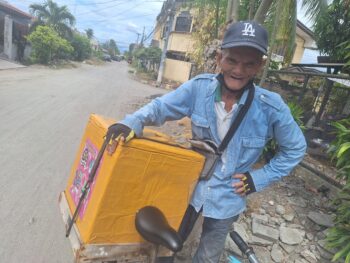
MAKATI CITY (MindaNews / 05 February) Since childhood, I have always been fascinated by oral elegance and verbal beauty.
As a kid in the 1970s, I can still remember my late mother listening to radio phono of Raguia sa Madaya[1] and Tangkli Benito,[2] especially in the afternoon.
An older cousin, who had always been our neighbor, was a raving fan of Bapa[3] Tangkli, and in particular, an avid listener of Mantanas-a Daungan.[4] He would listen the whole day – and would even be extended at night, had it not been for his wife’s unholy homily to him for that purpose.
On family occasions at our old residence near the Cave Spring at the heart of Cotabato City, it’s really entertaining to watch Babu[5] Palamanis of Dapiawan[6] exchanging bayuk with Bapa ‘Aziz of Adaon.[7] Whenever present, Babu Bakalat of Pandi[8] and Babu Genampay of Nimao[9] would also be in tandem with the former against the latter.
Even until now, it is as if I could still hear the audience’s boisterous laughter and shouts of encouragement as the gallant oral warriors were trading strikes long and short bayuk.
It’s really a balagtasan[10] duel in Maguindanaon vernacular – a male versus female-or-a-group-of-females duel at that. And the outcome of the contest was obvious as well.
When I was already in high school in 1985, my appreciation of bayuk naturally increased as I could then somehow understand it better – or so I thought.
As a result, no wonder, before I left Cotabato City bound for Marawi City in 1989 to pursue my tertiary level of education as a Full Scholar in Mindanao State University Main Campus, I compiled some bayuk of Babu Genampay.[11]
What is bayuk, by the way?
As a prominent example of Maguindanaon folk speech, the bayuk, or alternatively, bayok, which represents both its singular and plural forms, refers to lyric poetry, proverbs, and aphorisms.
It also refers to a Maguindanaon chant which is syllabic and tetrachordal. As a chanted repartee or story, bayuk usually encompasses such themes as praising a visitor or ruler, love affairs and marriage proposals, humorous and epic adventures, as well as notable events and innermost emotions.
As the Maguindanaon language is brimming with metaphors and analogies, whenever extra care is needed to express a sensitive feeling or issue, it is conventionally done through bayuk.
Fast forward to 2017.
Exactly after two long decades, I met Bapa Gharib, the ever-smiling young sage of Tangguapo[12] – again – and this time, in the city of the sitting President of the Republic.[13]
At the end of the training-workshop we both attended, he gave me on a silver platter a collection of his bayuk, which he aptly introduced with this quotation:
“The political aphorism of the present generation is doubted by the next, and completely discarded by the third.”
Well said, Bapa Gharib!
As we parted ways after the training-workshop, I told the young sage my intention of translating Maguindanaon bayuk, for which he nodded in approval and support.
Since then (2017), I have already started doing the translation – gradually.
Gradually.
Gradually, indeed.
For five long years…
I was also able to collect more bayuk and meet more pababayuk[14] (bayuk reciters or singers) during my barangay-level cultural mapping facilitations in preparation for the compilation of cultural property of the municipalities of Kabuntalan (2018) and Datu Anggal Midtimbang (2021) in the province of Maguindanao.
As I was doing the translation more seriously during the pandemic lockdowns for more than a year, my initial intention was just to transcribe and/or transliterate the bayuk and then offer the English translation alongside short annotations, whenever needed.
But then, after reading Bob Biensenbach’s bestselling Unleash the Power of Storytelling: Win Hearts, Change Minds, Get Results,[15] this question popped up in my mind as I was watering my plants at our as-far-as-the-eyes-can-see backyard plantation,[16] “How about bayuk within a story?”
Yes, “How about bayuk within a story?” I asked myself.
In other words, how about not just compiling the bayuk and their translations and annotations but also incorporating their own background stories so as to keep the readers aware of the context?
Yes, context, context, context.
By that time, I also recalled a private message in 2016 of a classmate of mine in elementary school. After reading a Facebook post of mine, which eventually became part of my published travelogue, Light Moments in Vienna,[17] on my training in interreligious and intercultural dialogue, she dropped me these lines via Facebook Messenger:
“I am looking forward to the next teaser. It’s good to know that one of my
batchmates has the gift of storytelling, as you do. I have always been
interested in writing, but never had the guts, or time, to actually do so.
Keep it up, Mans. You have come a long, wondrous way… from Central[18] to
Vienna.
P.S. Extend my salam to Soto,[19] that quick-witted fellow, hahaha!”
(Sad to note, my classmate can no longer read this ‘teaser’ because she passed away in mid-2020.)
So, with such added boost, I finally decided to transcribe and/or transliterate the compiled bayukalong with their own narratives, as much as I can.
Yes, I knew then that it would take me longer to finish the book, but at the same time, I do equally believe that it will be worth the efforts and the time – and the wait, of course, for you, esteemed readers.
This decision I made while keeping in view the fundamental difference between cultural heritage preservation and cultural heritage conservation.
As a lady lawyer of the NCCA[20] would inform us during a Mindanao-wide orientation and workshop on participatory cultural mapping for the inventory of cultural property in 2018,
“Preservation is when you do something in order for a cultural heritage to be there for the present and future generations to “see” whereas conservation is when you do something in order for a cultural heritage not just to be “seen” but also to be beneficial or be utilized by the present and future generations.”
In a sense, preservation is a static way of safekeeping while conservation is
something dynamic, as I understood it, at least.
In the case of bayuk – in this book, in particular – what we want is not just to keep a list of them and their translation for the young generation to read, recite, and better still, to put into memory, but rather to make the same readily available and for their practical use in their day-to-day conversations – whether online or offline. That is why we try to supply their contexts and narratives, so that our children and children’s children could be able to apply them in their own.
The bayuk translation may be considered its flesh while the story behind it or its context may be its soul.
The present collection consists of 13 bayuk (that is, 13 sets of bayuk) in both categories, viz., (1) bayukas lyric poetry, proverbs, and aphorisms, and (2) bayuk as a chant or song.
The first ten belong to the first category while the remaining three (Mantanas-a Daungan, Tudtulan sa Kinambakwit, and Twin Dancing Tanks of Zapakan) can be identified with the second classification.
One of them (Bayuk 9 – Remembering the Siege on ‘Eid) is an original composition of mine while the rest are those of other people.
In terms of the approach in translation, I have tried my best, as much as possible, to always strike a balance between what I call two R’s, viz., reliability and readability. By ‘reliability,’ I mean faithfulness and truthfulness to the original utterance of the bayuk, and by ‘readability,’ I’m referring to the fluency and clarity of the translation.
And whenever that is not possible due to my own difficulty in fathoming the meaning of the utterance, I would incline toward meaning-based translation instead of a literal style.
At the end of each chapter (or Bayuk), I have provided “Action Items” as a way of directly interacting with you – dear readers and bayuk-enthusiasts – to know your honest feedback and comments for the improvement of the translation.
Nowadays, as there has been a diminishing number of Maguindanaon pababayuk (bayuk-reciters) who could spontaneously compose bayuk or know them by heart, this book, ‘mBayuka Tanu! Maguindanaon Bayuk Transliteration, Translation, and Annotation, is a humble attempt not just to preserve but rather to conserve some elements, at least, of this intangible cultural heritage for the current and upcoming generations to understand, appreciate, and hopefully, adapt and innovate according to their own context/s.
Let’s recite bayuk (‘mBayuka tanu
[MindaViews is the opinion section of MindaNews. This piece is an excerpt from the Prologue of the forthcoming book written by the columnist. Mansoor L. Limba, PhD in International Relations, is a writer, university professor, blogger, chess trainer, and translator (from Persian into English and Filipino) with tens of written and translation works to his credit on such subjects as international politics, history, political philosophy, intra-faith and interfaith relations, cultural heritage, Islamic finance, jurisprudence (fiqh), theology (‘ilm al-kalam), Qur’anic sciences and exegesis (tafsir), hadith, ethics, and mysticism. He can be reached at mlimba@diplomats.com, or http://www.mlimba.com and http://www.muslimandmoney.com, and his books can be purchased at www.elzistyle.com.]
[1] Raguia sa Madaya (Rajah of Madaya) is a Maguindanaon epic ballad song. In our family possession as inherited from our late mother are 11 vinyl disks of Raguia sa Madaya produced in 1976 by the late Hadji Abdulsamad Abdullah of Mindanao Record Center and Gift Shop in front of Super Market, Cotabato City.
[2] Tangkli Benito: a popular Maguindanaon ballad singer, born in Maganoy, Maguindanao, Philippines.
[3] Bapa is the Maguindanaon word for ‘uncle’, which is also used to address an older man although not related to the speaker by consanguinity or affinity.
[4] Mantanas-a Daungan is translated and annotated in Bayuk 11 of the book.
[5] Babu is the Maguindanaon word for ‘aunt’.
[6] It refers to Barangay Dapiawan, Datu Saudi Ampatuan Municipality, Maguindanao Province, Philippines.
[7] It refers to Barangay Adaon, Datu Anggal Midtimbang Municipality, Maguindanao Province, Philippines.
[8] It refers to Barangay Pandi, Datu Salibu Municipality, Maguindanao Province, Philippines.
[9] It refers to Barangay Nimao, Datu Piang Municipality, Maguindanao Province, Philippines.
[10] Derived from the name of Francisco Balagtas, balagtasan is a Filipino form of debate done in verse, and which presents a type of literature in which thoughts or reasoning are expressed through speech.
[11] More about Babu Genampay in Bayuk 1 of the book.
[12] It refers to Sitio Tangguapo, Barangay Damabalas, Datu Piang Municipality, Maguindanao Province, Philippines.
[13] Read more about Bapa Gharib in Bayuk 3 of the book.
[14] As in the case of bayuk, in this book, pababayuk represents both the singular and plural forms of the word.
[16] Yes, I am an aspiring plantito, too. Plantito/plantita (literally, plant’s uncle (tito) or aunt (tita)) is a new social media Filipino jargon used to describe people who find joy and fulfillment in planting and gardening, usually as a coping mechanism to deal with anxieties brought by the COVID-19 pandemic community quarantine.
[17] See https://amzn.to/3u8DsCM. Digital copy of the book is also available here:
https://www.elzistyle.com/product/light-moments-in-vienna.
[18] By “Central,” my classmate meant our one-century-old elementary school, Cotabato City Central Pilot School (CCCPS), which was established in 1920.
[19] Soto is one of the real characters in the travelogue.
[20] It refers to the National Commission for Culture and the Arts (NCCA) of the Philippines.







